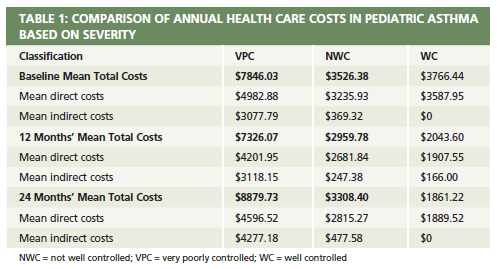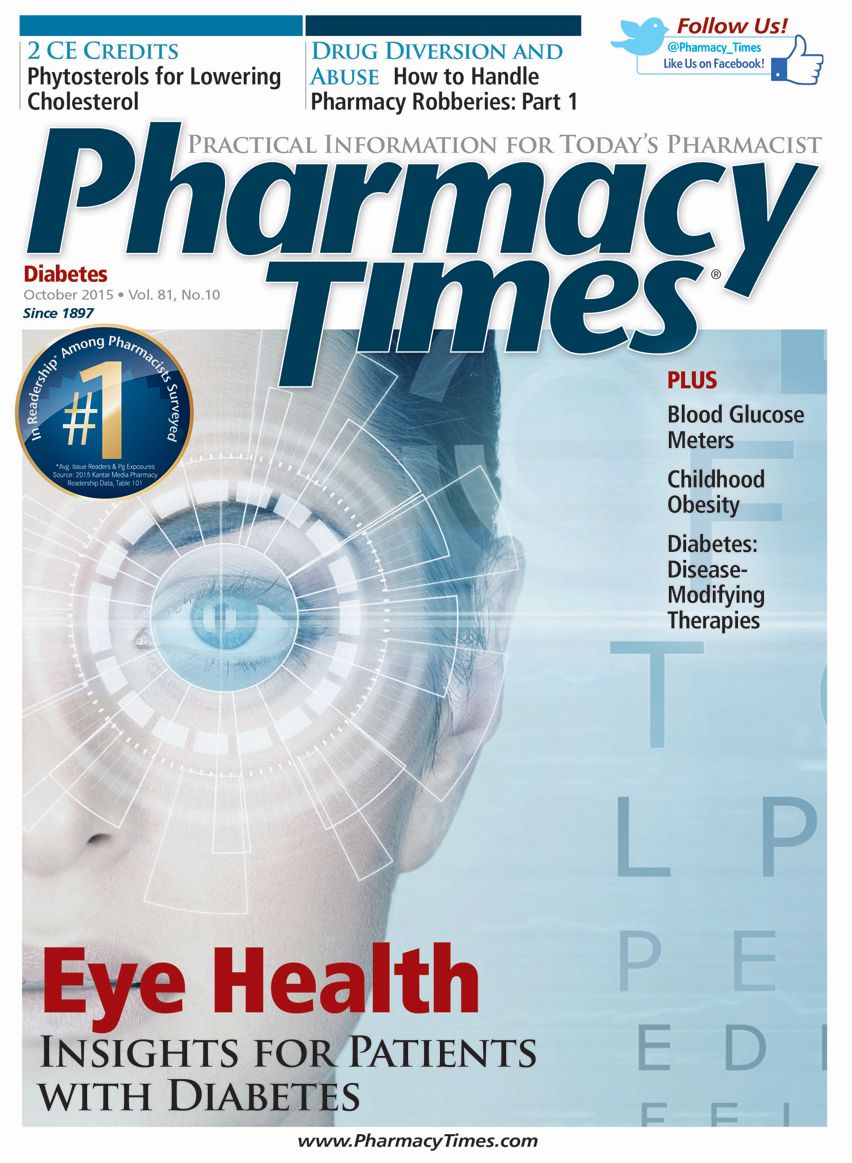Publication
Article
Pharmacy Times
Asthma: Helping Children and Caregivers Breathe Easier
Author(s):
Asthma is the most chronic inflammatory disease of the airways in children.
Epidemiology of Asthma in Children
Asthma, a chronic inflammatory disease that occurs in the airways due to a complex interaction of factors,1 is characterized by symptoms that cause reversible airway narrowing and increased airway responsiveness to a variety of stimuli. The reversible inflammation and airway obstruction caused by these factors may result in episodes of coughing, wheezing, shortness of breath, and tightness in the chest.2
Asthma is the most chronic inflammatory disease of the airways in children. The disease is also a growing concern in today’s health care system. According to the results of the 2013 National Health Interviews Survey, 8.3% of patients younger than 18 years have an active asthma diagnosis. This is equivalent to 6.11 million patients, 3 per million of whom die due to asthma.3 The patient age group with the highest prevalence of asthma is 5 to 14 years (4.08 million). Asthma is diagnosed more in boys than girls—9.3% vs 7.3%, respectively—and 57.9% of children younger than 18 years have reported having 1 or more asthma attacks.
Economic Burden
Several major reasons why asthma is poorly controlled within the pediatric patient population include a lack of health literacy, poor quality of life at home, and environmental triggers. In 2008, asthma was one of the most common reasons for absenteeism: children lost 14.4 million school days from asthma that year. Also, in 2010, close to 640,000 emergency department (ED) visits were due to asthma in patients younger than 15 years.4
Economically, the most recent data available heighten the concern regarding the economic burden of pediatric asthma in the United States. In 2007 (the year for which the most recent data are available), annual health care costs from asthma totaled $56 billion, with $27 billion spent on pediatric asthma. Of that $56 billion, $50.1 billion was attributed to total direct health care costs (ie, medication usage, ED visits, hospitalization, unscheduled office visits) and $5.9 billion was spent on indirect health care costs (ie, school/work days missed).5

To further highlight the financial and economic burdens of pediatric asthma, a study was conducted by Szefler and colleagues to assess the cost burden in children between 6 and 12 years of age with severe or complicated asthma.6 Children were classified either as very poorly controlled (VPC), not well controlled (NWC), or well controlled (WC); total costs were collected at baseline, 12 months, and 24 months. Mean annual total health care costs were more than twice as high in the VPC group compared with the NWC and WC groups, mean indirect costs made up half of mean total costs (P <.001) (Table 1), and medication use and school/work days lost contributed to most of the total cost burden (all P <.001). The group concluded that “attention to better management strategies including careful monitoring of control and adherence … are needed to reduce [the] asthma burden in this population of children” (emphasis added), especially as it relates to outpatient follow-up visits.6
Patient Counseling/ Monitoring Problems
A 2011 study published in The Journal of Pediatrics highlights the lack of follow-up in children with asthma.7 This retrospective cohort study measured what proportion of patients seen 2 months after their ED visit filled an inhaled corticosteroid prescription (eg, fluticasone propionate) or attended follow-up appointments.
Data were collected on more than 3000 children aged 2 to 18 years. Results revealed that after being discharged from the ED, 18% received an inhaled corticosteroid and 12% visited their physician for their follow-up appointment. Among children with severe asthma, patients are more likely to get their inhaled corticosteroid prescription filled (OR 2.9; 95% CI, 2.3-3.7) and attend their follow-up appointment (OR 2.0, 95% CI, 1.5-2.6). Children between 2 and 6 years of age (OR 0.71; 95% CI, 0.56-0.9) and those older than 12 years (OR 0.62; 95% CI, 0.47-0.83) were less likely to attend their follow-up visit (P <.0001 for all comparisons). Overall, children who are seen in the ED due to asthma are less likely to fill their inhaled corticosteroid prescription and follow up with their physician in an outpatient setting.
Further interventions must be made to ensure inhaled corticosteroid prescriptions are filled and children attend follow-up visits. Fortunately, there are ways for pharmacists to make specific interventions with available tools and resources that parents, caregivers, and children can use to better control asthma; reduce the physical and economic burdens of pediatric asthma; and improve their quality of life.
Patient Counseling and Resources
Despite the lack of time and training, resources are available that pharmacists can integrate into their work flow to better target pediatric patients with asthma. Video demonstrations and printout guides are available for parents, caregivers, and children to use (Online Table 2). Pharmacists can also print out a sheet from which parents/ caregivers with smart devices can scan designated QR codes to receive video instructions on specific inhaler devices.8
Table 2: Patient Counseling Printout Resources
Description
Website
Printout?
Metered dose inhaler techniques
www.cdc.gov/asthma/inhaler_video/default.htm
Yes
Combivent respimat inhaler technique
www.combivent.com/how/index.php
Diskus technique (eg, Advair, Flovent, Serevent)
www.gsksource.com/pharma/content/dam/GlaxoSmithKline/US/en/Prescribing_Information/Advair_Diskus/pdf/ADVAIR-DISKUS-PI-MG.PDF#nameddest=MG
Yes
Pulmicort Flexhaler
http://pharmacistsletter.therapeuticresearch.com/pl/Articlepdf.aspx?cs=&s=pl&dd=300252&segment=6644
Yes
Asmanex Twisthaler
www.nationaljewish.org/healthinfo/medications/lung-diseases/devices/dry-powder/twisthaler/
Yes
The American Lung Association has a website comparing various asthma-management mobile apps based on goals, compatible smart device, and cost.9 For pharmacists who desire to be better informed about asthma management, a clinical pharmacy certificate program is available that is accredited by the Accreditation Council for Pharmacy Education and can count toward their continuing education requirements for their respective jurisdictions.10
With resources available at their disposal, pharmacists can begin making targeted interventions that will result in better control and management of pediatric asthma, a reduced incidence of ED visits and hospitalizations, decreased health care spending, and an overall better quality of life for children, parents, and caregivers. That way, we can all breathe easier and with relief.
Brian J. Catton, PharmD, graduated from the Bernard J. Dunn School of Pharmacy at Shenandoah University in Winchester, Virginia, in 2010. He received the Distinguished Young Pharmacist Award from the New Jersey Pharmacists Association in 2014 and founded its New Practitioner Network in 2015. He is a scientific communications manager at AlphaBioCom in King of Prussia, Pennsylvania. His areas of interest include pediatrics, immunizations, drug-therapy management, social media, patient counseling, and immuno-oncology.
References
- Assemi M, Morello C. Diabetes mellitus. In: Krinsky D, Berardi R, Ferreri S, et al, eds. Handbook of Nonprescription Drugs. 1st ed. Lenexa, KS: American College of Clinical Pharmacy; 2013.
- Asthma prevalence in the United States. Centers for Disease Control and Prevention website. www.cdc.gov/asthma/asthma_prevalence_in_us.pptx. Published June 2014. Accessed June 17, 2015.
- Most recent asthma data. Centers for Disease Control and Prevention website. www.cdc.gov/asthma/most_recent_data.htm. Published 2013. Accessed June 17, 2015.
- Asthma & children fact sheet. American Lung Association website. www.lung.org/lung-disease/asthma/resources/facts-and-figures/asthma-children-fact-sheet.html#5. Published September 2014. Accessed June 17, 2015.
- Patel K, Farmer S, George M, McStay F, McClellan M. Pediatric asthma: an opportunity in payment reform and public health. Health Affairs blog. http://healthaffairs.org/blog/2014/09/18/pediatric-asthma-an-opportunity-in-payment-reform-and-public-health/. Published September 18, 2014. Accessed June 14, 2015.
- Szefler SJ, Zeiger RS, Haselkorn T, et al. Economic burden of impairment in children with severe or difficult-to-treat asthma. Ann Allergy Asthma Immunol. 2011;107(2):110-119. doi: 10.1016/j.anai.2011.04.008.
- Andrews AL, Teufel RJ, Basco WT Jr. Low rates of controller medication initiation and outpatient follow-up after emergency department visits for asthma. J Pediatr. 2012;160(2):325-330. doi: 10.1016/j.jpeds.2011.07.037.
- Video instructions for different inhaler devices. Pharmacist’s Letter website. http://pharmacistsletter.therapeuticresearch.com/pl/Articlepdf.aspx?cs=&s=pl&dd=300252&segment=6644. Published January 2014. Accessed June 17, 2015.
- Mobile apps and asthma management. American Lung Association website. www.lung.org/associations/charters/plains-gulf/news/mobile-apps-and-asthma.html?referrer=https://www.google.com/. Published March 7, 2014. Accessed June 17, 2015.
- Asthma clinical pharmacy certificate program. Centers for Innovative Pharmacy Solutions, University of Maryland School of Pharmacy. www.pharmacists4knowledge.org/cips/courses/view/66. Accessed June 17, 2015.







